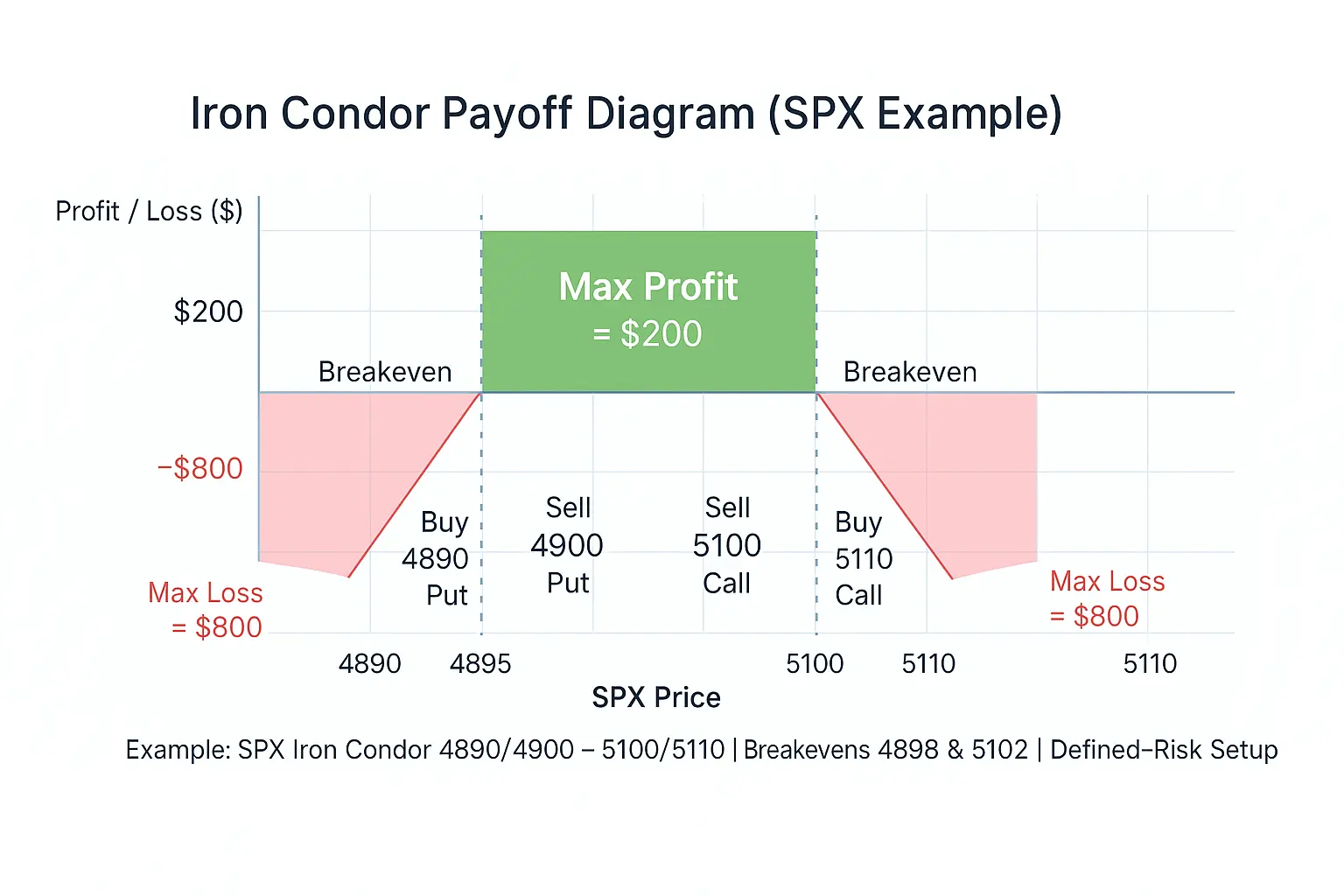How the Iron Condor Works
An Iron Condor is built from two credit spreads—one on each side of the current price range. Think of it like setting invisible goalposts. As long as the market (the ball) stays between those posts, you score.
- Sell one put option (higher strike) and buy one lower-strike put for downside protection → bull put spread.
- Sell one call option (lower strike on the top side) and buy a higher-strike call to cap the risk → bear call spread.
Both sides collect credit. Combined, they form an Iron Condor—a trade that profits if the price stays inside the range between your short call and short put strikes. In short, you’re selling time and volatility. Each day that the price stays calm, your position gains value. That’s why I call it the “steady flier” of the options world.
If you’re new to Iron Condors, start with our main guide —
Iron Condor SPX Strategy: Profit From Low Volatility Safely.
It explains how SPX Iron Condors work, when to trade them, and how professionals manage risk.
Max Profit and Max Loss Explained
Here’s the golden question every trader asks: “How much can I make and how much can I lose?” Let’s break it down.
Maximum Profit:
Your max profit is the total net credit received when opening the trade. You earn that full amount if the underlying stays between your short strikes at expiration.
Example setup:
- Sell 1 5100 Call and buy 1 5110 Call.
- Sell 1 4900 Put and buy 1 4890 Put.
- Total net credit received: $2.00 (i.e., $200 per Iron Condor).
If SPX finishes between 4900 and 5100, you keep the entire credit.
Maximum Loss (Defined Risk):
Your Iron Condor max loss happens if price breaks completely past one side. Formula:
Max Loss = Spread Width − Net Credit
With each spread 10 points wide and a $2.00 credit, max loss = $10 − $2.00 = $8.00 (i.e., $800 per Condor). The key advantage: risk is defined upfront.
Breakeven Points:
- Upper Breakeven =
Short Call Strike + Credit→ 5100 + 2 = 5102 - Lower Breakeven =
Short Put Strike − Credit→ 4900 − 2 = 4898
As long as SPX finishes between those two prices, you walk away profitable.

Iron Condor Payoff Diagram Example
The classic iron condor payoff diagram looks like a flat-topped hill: profit in the middle, limited losses on both sides.
- Max profit sits in the center (between the short strikes).
- Loss begins once price crosses a breakeven line.
- Loss is capped by the long options you bought (defined risk).
Visual cue: Show a flat zone between 4900–5100 labeled “Max Profit,” with losses tapering beyond breakevens near 4898 and 5102. If you use an iron condor payoff calculator, you’ll see how theta (time decay) adds up daily. As time passes and volatility cools off, the position naturally gains value—so long as price stays inside the range.
This is why Iron Condors tend to work best in low-to-moderate volatility markets.
SPX Iron Condor Example
Let’s walk through a real-world SPX Iron Condor example — the kind of setup I actually trade.
- SPX at 5050
- Days to expiration: 3
- Volatility: Moderate (VIX around 16)
Setup:
- Sell 1 5140 Call @ 6.00
- Buy 1 5150 Call @ 5.00
- Sell 1 4950 Put @ 6.50
- Buy 1 4940 Put @ 5.50
Total credit = (6 + 6.5) − (5 + 5.50) = $2.00.
Payoff:
- Max profit: $200 if SPX stays between 4950–5140.
- Max loss: $800 if SPX breaks below 4940 or above 5150.
- Breakevens: 4948 and 5142.
This is a classic short iron condor setup — you collect premium upfront and profit when the market stays quiet. You can also explore the long iron condor, where you pay a debit and benefit from big market moves. But for most traders (myself included), the short version offers steady, defined-risk income potential.
Risk Management and Trade Planning
Now, let’s talk about what separates hobbyists from pros: Iron Condor risk management. When I trade, I don’t rely on hope — I plan exits and size positions with discipline. Here are my simple rules:
- Define Profit Targets: Aim to close when you’ve captured 50–70% of max profit. Don’t try to squeeze every dollar; risk accelerates near expiration.
- Avoid Holding Too Long: Time decay speeds up in the final days, but so does gamma risk. If SPX touches your short strikes close to expiration, a small move can flip a winner into a loser.
- Use Volatility to Your Advantage: Enter Condors when implied volatility is slightly above average but stable. When volatility drops, your position gains value — that’s “vol crush,” and it’s your friend.
- Track and Review Every Trade: Log your entries, exits, duration, and market conditions. Patterns emerge — maybe you hold too long or open too close to expiration. Tracking improved my own consistency more than any indicator ever did.
For a deeper dive on adjustments, see my related article: Iron Condor vs. Iron Butterfly.
Final Thoughts
The Iron Condor strategy is one of my all-time favorites because it rewards patience, discipline, and understanding over adrenaline. Once you master the iron condor payoff diagram, you’ll realize every trade is a probability game — you know your reward, your max loss, and your risk before entering.
That’s the kind of clarity most traders never achieve. Whether you trade SPX, QQQ, or RUT, remember: the Iron Condor isn’t about predicting direction — it’s about managing time, volatility, and confidence. When you’re ready to trade like a professional, automation can take it to the next level.
Automate your Iron Condor trading with our Weekly Premium Signals for SPX. Get real trade alerts to target 5% weekly ROI, risk management insights, and see how defined-risk trading can build consistent income.
Iron Condor FAQs
What is the maximum profit in an Iron Condor?
The maximum profit is the total credit received when you open the trade. You earn that full amount if the underlying stays between your short call and short put strikes at expiration.
How is the max loss calculated?
Your max loss is the spread width minus the credit received. It happens only if price moves completely past one of your long strikes. The key benefit of the Iron Condor is that this risk is clearly defined before you enter.
When does an Iron Condor work best?
An Iron Condor performs best in low-to-moderate volatility markets when prices stay within a predictable range. Traders often use it when implied volatility is slightly elevated, so that time decay (theta) works in their favor as volatility drops.
Can I trade Iron Condors on SPX or SPY?
Yes. Many professional traders use SPX and SPY options for Iron Condors because of their tight spreads, high liquidity, and cash-settled nature. SPX is especially popular for defined-risk income strategies.
How can I reduce risk with Iron Condors?
Keep position size reasonable, close trades once you’ve captured 50–70% of potential profit, and avoid holding through major news or earnings. Those steps help control risk and improve consistency.

